Nombre total de pages vues
30/06/2020
29/06/2020
Science & Technology - Astronomy pictrure of the day : Dark Sky Reflections
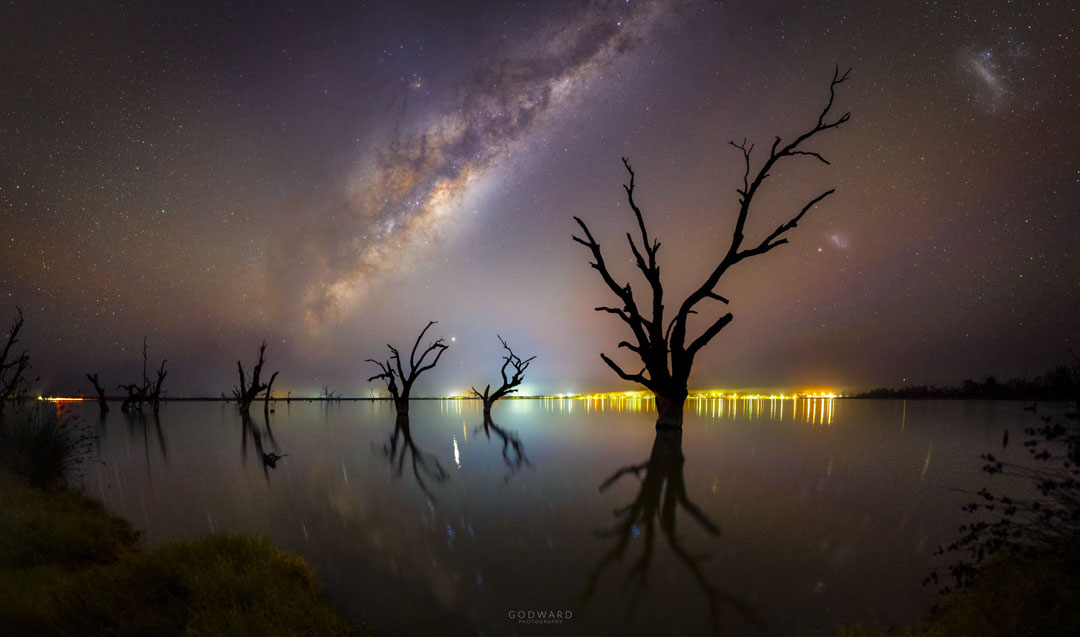
Image Credit & Copyright: Will Godward
Explanation: When the lake calmed down, many wonders of the land and sky appeared twice. Perhaps the most dramatic from the dark sky was the central band of our Milky Way Galaxy, visible as a diagonal band. Toward the right were both the Small (SMC) and Large (LMC) Magellanic Clouds, satellite galaxies of our Milky Way. Faint multicolored bands of airglow fanned across the night. Numerous bright stars were visible including Antares, while the bright planet Jupiter appears just above the image center. The featured image is a composite of exposures all taken from the same camera and from the same location within 30 minutes in mid-May from the shore of Lake Bonney Riverland in South Australia. Dead trees that extend from the lake were captured not only in silhouette, but reflection, while lights from the small town of Barmera were visible across the lake. In July, Jupiter and Saturn will rise toward the east just as the Sun sets in the west.
28/06/2020
Science & Technology - Astronomy picture of the day : Eclipse under the ISS :
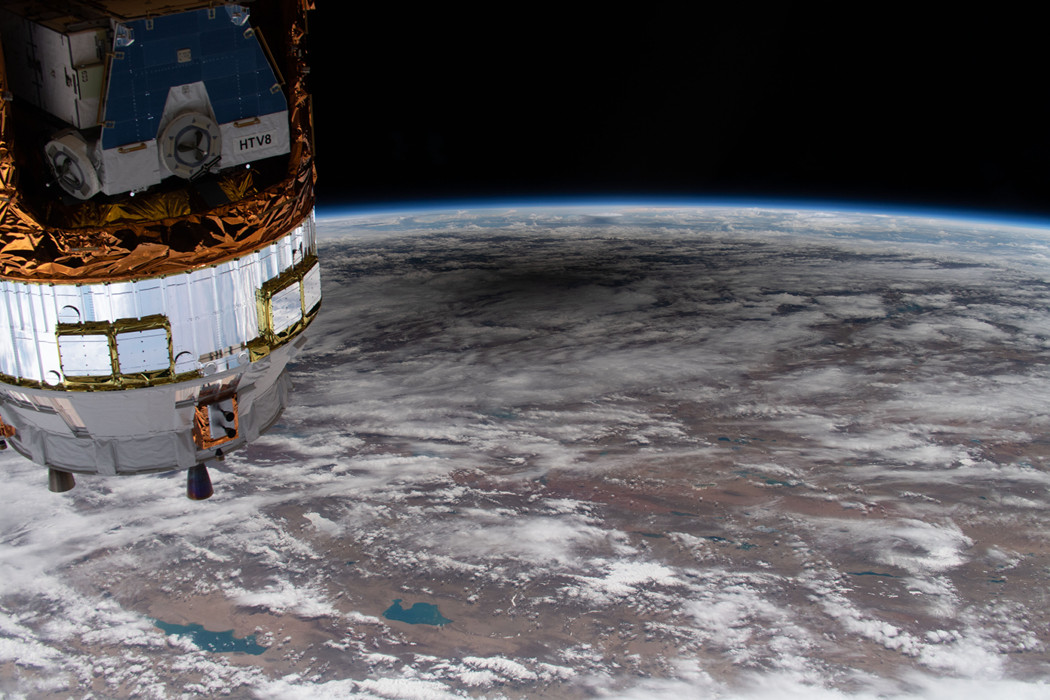
Image Credit: NASA ISS Expedition 63
Explanation: The dark shadow of the New Moon reached out and touched planet Earth on June 21. A high definition camera outside the International Space Station captured its passing in this snapshot from low Earth orbit near the border of Kazakhstan and China. Of course those along the Moon's central shadow track below could watch the much anticipated annular eclipse of the Sun. In the foreground a cargo spacecraft is docked with the orbital outpost. It's the H-II Transfer Vehicle-9 from JAXA the Japan Aerospace Exploration Agency.
Science & Technology - Astronomy picture of the day : Europa and Jupiter from Voyager 1 :

Explanation: What are those spots on Jupiter? Largest and furthest, just right of center, is the Great Red Spot -- a huge storm system that has been raging on Jupiter possibly since Giovanni Cassini's likely notation of it 355 years ago. It is not yet known why this Great Spot is red. The spot toward the lower left is one of Jupiter's largest moons: Europa. Images from Voyager in 1979 bolster the modern hypothesis that Europa has an underground ocean and is therefore a good place to look for extraterrestrial life. But what about the dark spot on the upper right? That is a shadow of another of Jupiter's large moons: Io. Voyager 1 discovered Io to be so volcanic that no impact craters could be found. Sixteen frames from Voyager 1's flyby of Jupiter in 1979 were recently reprocessed and merged to create the featured image. About 43 years ago, Voyager 1 launched from Earth and started one of the greatest explorations of the Solar System ever.
26/06/2020
Science & Technologie - Astronomy picture of the day : Eclipse under the Bamboo :
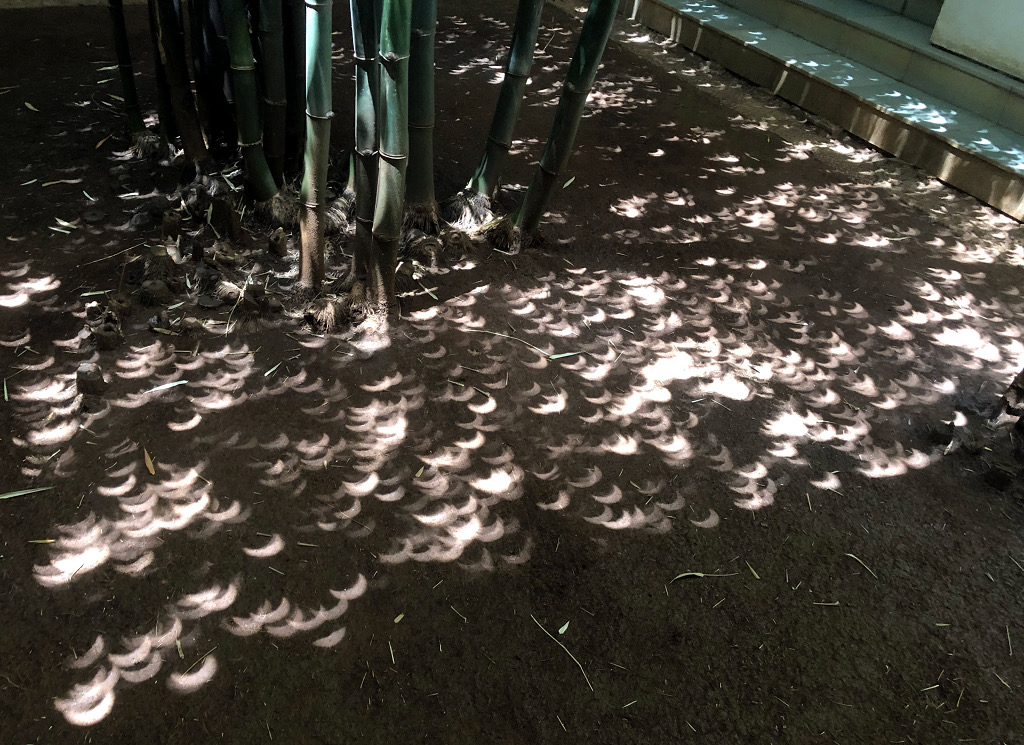
Image Credit & Copyright: Somak Raychaudhury (Inter-University Centre for Astronomy & Astrophysics)
Explanation: Want to watch a solar eclipse safely? Try looking down instead of up, though you might discover you have a plethora of images to choose from. For example, during the June 21st solar eclipse this confusing display appeared under a shady bamboo grove in Pune, India. Small gaps between close knit leaves on the tall plants effectively created a network of randomly placed pinholes. Each one projected a separate image of the eclipsed Sun. The snapshot was taken close to the time of maximum eclipse in Pune when the Moon covered about 60 percent of the Sun's diameter. But an annular eclipse, the Moon in silhouette completely surrounded by a bright solar disk at maximum, could be seen along a narrow path where the Moon's dark shadow crossed central Africa, south Asia, and China.
24/06/2020
Science & Technology - Astronomy picture of the day : Inverted City Beneath Clouds :

Explanation: How could that city be upside-down? The city, Chicago, was actually perfectly right-side up. The long shadows it projected onto nearby Lake Michigan near sunset, however, when seen in reflection, made the buildings appear inverted. This fascinating, puzzling, yet beautiful image was captured by a photographer in 2014 on an airplane on approach to Chicago's O'Hare International Airport. The Sun can be seen both above and below the cloud deck, with the latter reflected in the calm lake. As a bonus, if you look really closely -- and this is quite a challenge -- you can find another airplane in the image, likely also on approach to the same airport.
21/06/2020
Science & Technology - Astronomy picture of the day : Moon Occults Venus
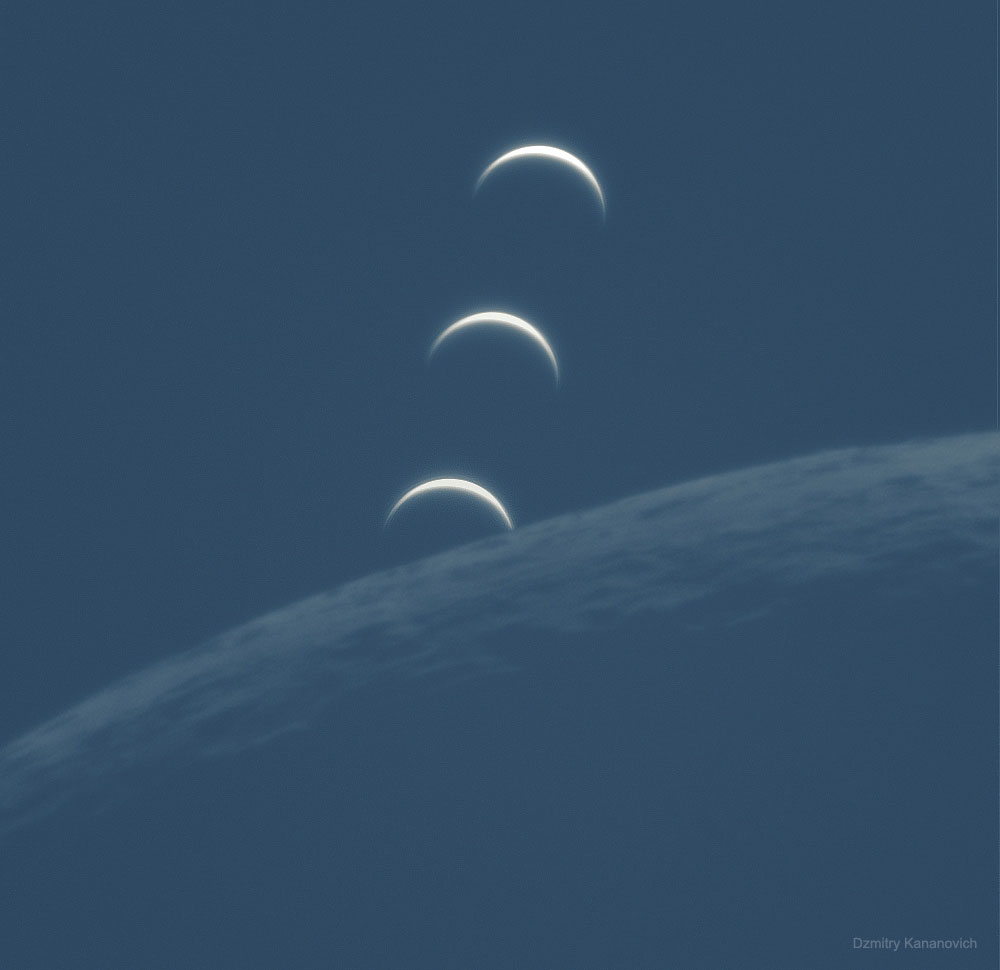
Image Credit & Copyright: Dzmitry Kananovich
Explanation: It may look like Earthrise, but it's actually Venus-set. Just after sunrise two days ago, both the Moon and Venus also rose. But then the Moon overtook Venus. In the featured image sequence centered on the Moon, Venus is shown increasingly angularly close to the Moon. In the famous Earthrise image taken just over 50 years ago, the Earth was captured rising over the edge of the Moon, as seen from the Apollo 8 crew orbiting the Moon. This similar Venus-set image was taken from Earth, of course, specifically Estonia. Venus shows only a thin crescent because last week it passed nearly in front of the Sun, as seen from Earth. The Moon shows only a thin crescent because it will soon be passing directly in front of the Sun, as seen from Earth. Today, in fact, two days after this image was taken, the Moon will create a solar eclipse, with a thin swath across the Earth treated to an annular solar eclipse.
Santé/Médecine - Guérir sans gagner d'argent : les laboratoires s'interrogent !
En médecine, de nouveaux médicaments contre les maladies génétiques très rares sont en train de voir le jour. L'un des premiers cas est celui de Mila Makovec, une jeune fille souffrant d'une maladie génétique unique, qui a reçu un traitement conçu spécifiquement pour elle.
Remplacer, modifier ou supprimer des gènes n'a jamais été aussi facile. Reste à répondre à une question cruciale: qui paiera pour ces médicaments alors qu'ils n'aident à chaque fois qu'une seule personne et demandent de lourds investissements humains?
Les capitalistes i.e. les laboratoires s'interrogent...
20/06/2020
Science & Technology - Astronomy picture of the day : Northern Summer on Titan
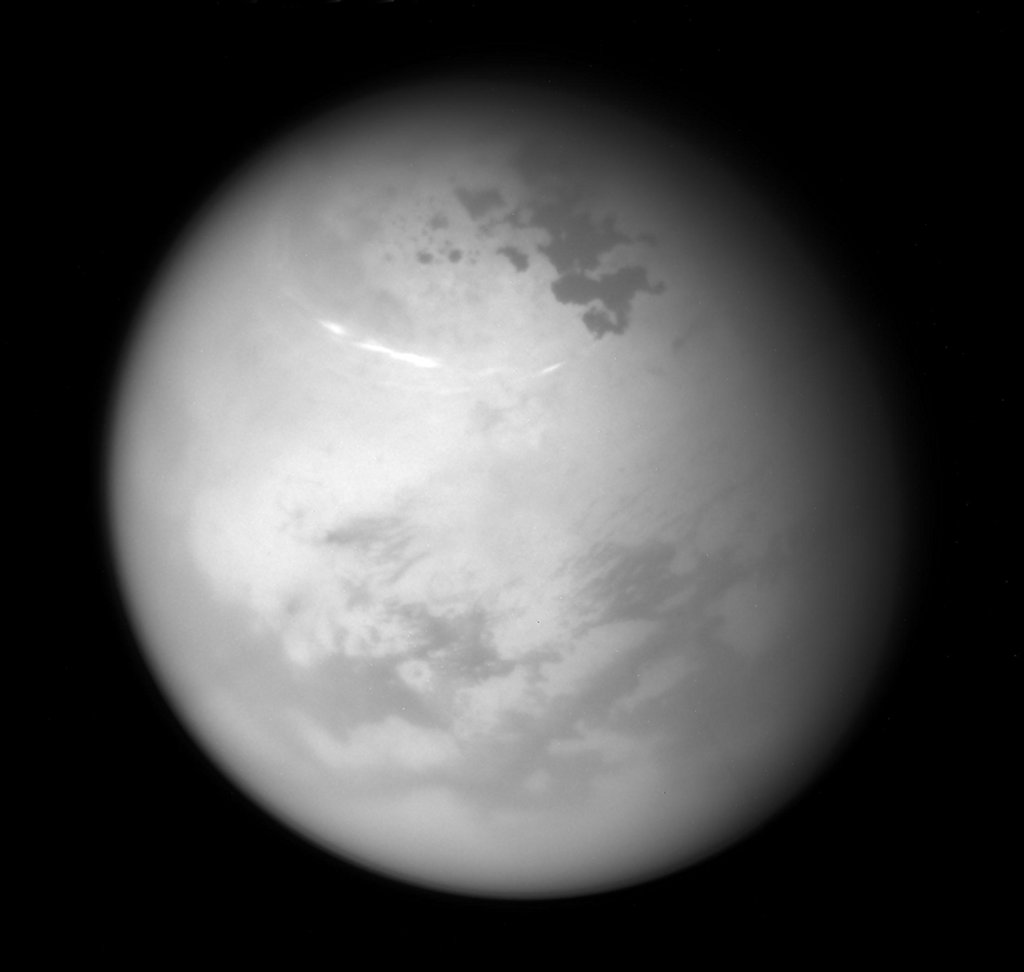
Explanation: Today's solstice brings summer to planet Earth's northern hemisphere. But the northern summer solstice arrived for ringed planet Saturn over three years ago on May 24, 2017. Orbiting the gas giant, Saturn's moon Titan experiences the Saturnian seasons that are about 7 Earth-years long. Larger than inner planet Mercury, Titan was captured in this Cassini spacecraft image about two weeks after its northern summer began. The near-infrared view finds bright methane clouds drifting through Titan's dense, hazy atmosphere as seen from a distance of about 507,000 kilometers. Below the clouds, dark hydrocarbon lakes sprawl near its fully illuminated north pole.
Science & Technologie - La Terre vue du ciel : L’île de Kyūshū au Japon

L'île de Kyūshū est la parfaite illustration de la complexité de l'œkoumène du Japon qui se trouve à l'intersection de quatre plaques tectoniques : le Pacifique, la mer des Philippines, l'Amérique du Nord, et l'Eurasie. Kyūshū se situe sur une zone de subduction où une plaque tectonique plonge sous une autre, donnant naissance à une topographie mêlant montagnes, plaines, volcans actifs (mont Unzen) et éteints (mont Tara).
Sur cette image satellite dont les couleurs ont été simulées, l'eau est bleue, la végétation verte et les zones urbaines sont en blanc et dégradé de bleu-gris. On peut ainsi se rendre compte de l'intrication complexe entre les zones habitées et montagneuses.
19/06/2020
Science & Technology - Astronomy pictures of the day : The Veins of Heaven

Image Credit & Copyright: Ruslan Merzlyakov (RMS Photography)
Explanation: Transfusing sunlight through a darkened sky, this beautiful display of noctilucent clouds was captured earlier this week, reflected in calm waters from Nykobing Mors, Denmark. From the edge of space, about 80 kilometers above Earth's surface, the icy clouds themselves still reflect sunlight, though the Sun is below the horizon as seen from the ground. Usually spotted at high latitudes in summer months the night shining clouds have made an early appearance this year as northern nights grow short. Also known as polar mesopheric clouds they are understood to form as water vapor driven into the cold upper atmosphere condenses on the fine dust particles supplied by disintegrating meteors or volcanic ash. NASA's AIM mission provides daily projections of noctilucent clouds as seen from space.
Science & Technologie - Informatique : Un internet quantique inviolable
À l'université de technologie de Delft, une équipe de scientifiques conduite par Stephanie Wehner est en train de créer un réseau reliant quatre villes au Pays-Bas, uniquement via la technologie quantique.
Cette technologie repose sur un phénomène particulier appelé «intrication quantique». La particularité de ce phénomène est que les données intriquées ne peuvent pas être lues sans que leurs contenus ne soient compromis –une sécurité parfaite, en somme.
17/06/2020
Science & Technology - Astronomy picture of the day : Magnetic Streamlines of the Milky Way
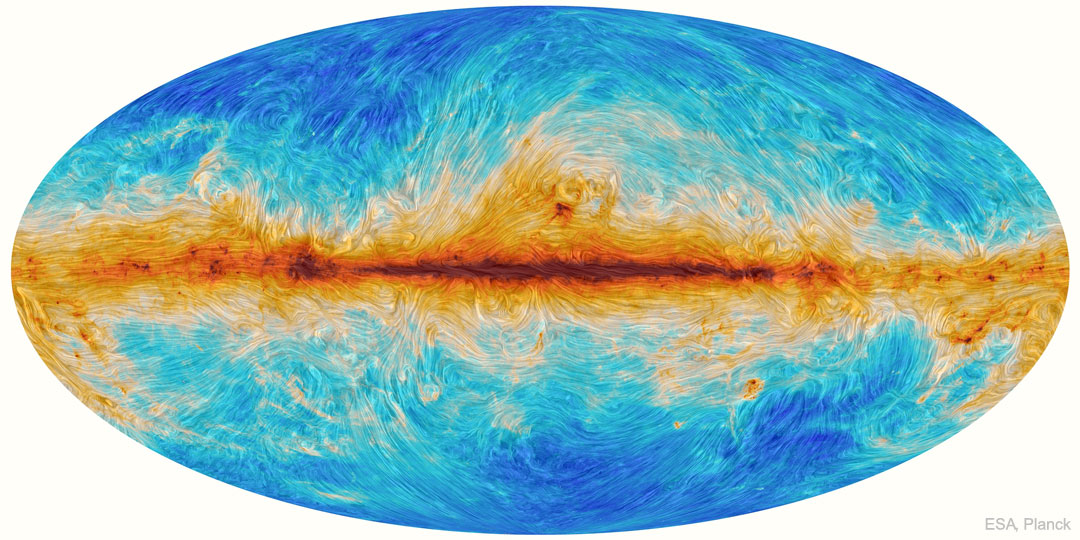
Image Credit: ESA, Planck; Text: Joan Schmelz (USRA)
Explanation: What role do magnetic fields play in interstellar physics? Analyses of observations by ESA's Planck satellite of emission by small magnetically-aligned dust grains reveal previously unknown magnetic field structures in our Milky Way Galaxy -- as shown by the curvy lines in the featured full-sky image. The dark red shows the plane of the Milky Way, where the concentration of dust is the highest. The huge arches above the plane are likely remnants of past explosive events from our Galaxy's core, conceptually similar to magnetic loop-like structures seen in our Sun's atmosphere. The curvy streamlines align with interstellar filaments of neutral hydrogen gas and provide tantalizing evidence that magnetic fields may supplement gravity in not only in shaping the interstellar medium, but in forming stars. How magnetism affected our Galaxy's evolution will likely remain a topic of research for years to come.
16/06/2020
Science & Technology - Astronomy picture of the day : A Ring of Fire Sunrise Solar Eclipse: :
Video Credit: Colin Legg & Geoff Sims; Music: Peter Nanasi
Explanation: What's rising above the horizon behind those clouds? It's the Sun. Most sunrises don't look like this, though, because most sunrises don't include the Moon. In the early morning of 2013 May 10, however, from Western Australia, the Moon was between the Earth and the rising Sun. At times, it would be hard for the uninformed to understand what was happening. In an annular eclipse, the Moon is too far from the Earth to block the entire Sun, and at most leaves a ring of fire where sunlight pours out around every edge of the Moon. The featured time-lapse video also recorded the eclipse through the high refraction of the Earth's atmosphere just above the horizon, making the unusual rising Sun and Moon appear also flattened. As the video continues on, the Sun continues to rise, and the Sun and Moon begin to separate. This weekend, a new annular solar eclipse will occur, visible from central Africa, the Arabian Peninsula, and a narrow band across Asia, with much of Earth's Eastern hemisphere being able to see a partial solar eclipse.
Inscription à :
Articles (Atom)
SANTé/MEDECINE - Virus et bactéries mortels - Le virus de la rage
Grâce aux travaux de Louis Pasteur , la rage a très nettement reculé dans le monde. On dénombre tout de même plus de 50.000 morts humains s...

-
2021 May 11 Lightning and Orion Beyond Uluru Image Credit & Copyright: Park Liu Explanation: What's happening behind Uluru? A Un...
-
The Witch Head Nebula Image Credit & Copyright: Digitized Sky Survey (POSS II); Processing: Utkarsh Mishra Explanation: ...
